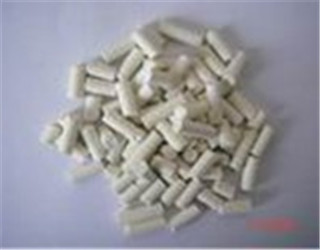 1. Features and Scope
of Application
1. Features and Scope
of Application
Zinc Oxide Desulfurization Adsorbent T305 is widely applicable to
feedstock purification processes in production of hydrogen, ammonia, alcohols
and organic chemicals. It can remove hydrogen sulfide from various feed gases
(oils) to as low as less than 0.1ppm.
Main reaction of the desulfurization process is as follows:
H2S+ZnS=ZnS+H2O
The adsorbent also is capable of converting and absorbing simple organic sulfur
such as COS and CS2.
Adsorbent T305 is highly adaptable. It can work in severe conditions with high
sulfur absorption capacity, high activity, high strength , good sustainability
for activity and sulfur absorption capacity, and good tolerance to high steam
to gas ratio. It can obtain satisfactory operation results both at higher ( about
400℃) and lower (about 200℃) temperature.
2.Composition and
Physical Properties
3.Quality
Standard

4.Normal Operation
Condition

Feedstock: light oil , residue cracking gas, natural gas, synthesis gas, coal
gas and shifted gas, with recommended hydrogen sulfide concentration of less
than 250 ppm.

5.Poisons
Oxygen: oxygen content in feed gas(oil) should not exceed 0.5%. Excessive
oxygen may lower breakthrough sulfur capacity of the adsorbent.
Chlorine: Chlorine presence in any state will affect desulfurization result.
6.Loading
Loading depth: recommended loading depth/ reactor diameter ratio is 3, so
as to ensure enough residence time of the gases in the bed. Configuration of
two reactors in series can improve utilization efficiency of the adsorbent.
Loading procedure:
(1) Clean the reactor before loading;
(2) Screen the adsorbent to remove dust;
(3) Load a layer of refractory spheres at both top and bottom of the
adsorbent bed. The refractory is separated from the adsorbent by stainless nets
with mesh size smaller than the adsorbent;
(4) Use special tool to ensure evenly distribution of the adsorbent both
in the center and around the inner wall;
(5)Inspect uniformity of the bed during loading. When inner-reactor operation
is needed, A wood plate should be put on the adsorbent for the operator to
stand upon.
(6)A stainless net and a 50mm layer of refractory spheres should be installed
at the top of the adsorbent bed so as to prevent entrainment of the adsorbent
and ensure even distribution of the gas stream.
7.Start-up
(1)Replace the system by nitrogen or other inert gases until oxygen
concentration in the gas is less than 0.5%;
(2)Preheat the feed stream with nitrogen, purge gas or synthesis gas under
ambient or elevated pressure;
(3)Heating speed: 30-50℃/h from room temperature to 120℃, 120℃ for 2 h, 50℃/h over 120℃ until required temperature is attained. Keep at the
temperature for 4h.
(4)Elevate the pressure at 0.5MPa/10 min during the thermostatic steps until
the operation pressure is attained.
(5)After pre-heating and pressure elevation, the system should be operated at
half load to regulate temperature, pressure and flowrate. Then raise the load
steadily when operation becomes stable till full-scale operation.
(6)If pressure elevation is done prior to pre-heating, careful control is
needed in accordance to the procedure above. Rapid temperature rise may cause
stress and result in pulverization of the adsorbent.